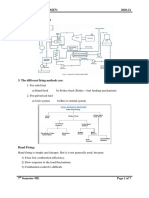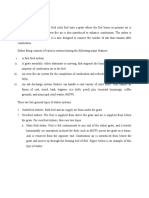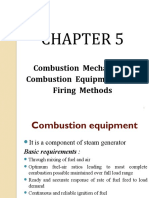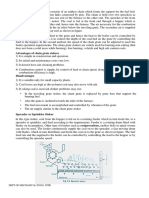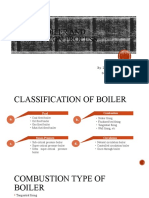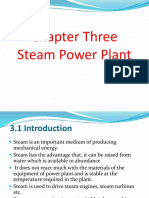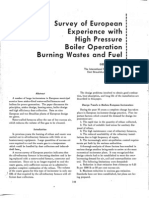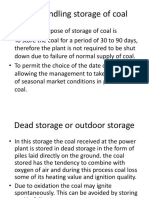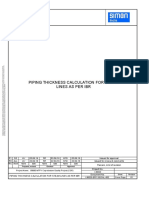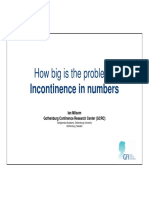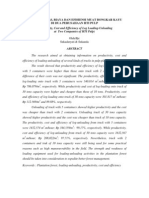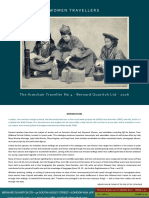0 ratings0% found this document useful (0 votes)
167 views0 pagesChap 16
Stokers are designed to feed fuel onto a grate where it burns with undergrate air (UGA) and overfire air (OFA) the grate is located within the lower furnace and is designed to remove the ash residue after combustion. Modern mechanical stoker / grate system designs are available to burn a wide range of fuels.
Uploaded by
Aun EaknarinCopyright
© Attribution Non-Commercial (BY-NC)
We take content rights seriously. If you suspect this is your content, claim it here.
Available Formats
Download as PDF, TXT or read online on Scribd
0 ratings0% found this document useful (0 votes)
167 views0 pagesChap 16
Stokers are designed to feed fuel onto a grate where it burns with undergrate air (UGA) and overfire air (OFA) the grate is located within the lower furnace and is designed to remove the ash residue after combustion. Modern mechanical stoker / grate system designs are available to burn a wide range of fuels.
Uploaded by
Aun EaknarinCopyright
© Attribution Non-Commercial (BY-NC)
We take content rights seriously. If you suspect this is your content, claim it here.
Available Formats
Download as PDF, TXT or read online on Scribd
You are on page 1/ 0
Steam 41 / Stokers 16-1
The Babcock & Wilcox Company
Chapter 16
Stokers
Many technologies have evolved to convert a wide
variety of fuels to alternate forms of energy. One im-
portant technology is the mechanical stoker. All stok-
ers are designed to feed fuel onto a grate where it
burns with undergrate air (UGA) passing up through
it, and overfire air (OFA) passing over it. The grate is
located within the lower furnace and is designed to
remove the ash residue after combustion. Evolving
from the hand-fired boiler era, mechanical stoker/
grate system designs are available to burn a wide
range of fuels for industrial, small utility and cogen-
eration applications. In addition to burning all forms
of coal, other fuels burned include sludge, wood waste
and biomass (e.g., wood, bark, straw, bagasse, rice
hulls, peach pits, almond shells, orchard prunings,
coffee grounds), as well as residential, agricultural,
industrial and commercial refuse. Modern mechani-
cal stoker firing systems are composed of:
1. a stoker or fuel feeding system,
2. a stationary or moving grate assembly to support
the burning mass of fuel and admit undergrate air
to the fuel,
3. an OFA system to complete combustion and limit
atmospheric pollutant emissions, and
4. an ash or residual discharge system.
These components are then integrated into the over-
all furnace design to optimize combustion and heat
recovery while minimizing unburned fuel, atmo-
spheric emissions and cost.
Despite the functional differences stated above, it
is not uncommon to hear or see the term stoker refer-
ring to not only the feeding device but also the entire
system, including the grate and air system. The feed-
ing device can also be referred to as a feeder, distribu-
tor or spout, as well as a stoker.
A successful installation requires selecting the cor-
rect type and size of stoker for the fuel being used and
for the load conditions and capacity being served.
There are two general types of systems: underfeed and
overfeed. Underfeed stokers supply both the fuel and
air from under the grate while overfeed stokers sup-
ply fuel from above the grate and air from below the
grate. Overfeed stokers are further divided into two
types: mass feed and spreader. In the mass feed stoker,
fuel is continuously fed to one end of the grate sur-
face and travels horizontally across the grate as it
burns. The residual ash is discharged from the oppo-
site end. Combustion air is introduced from below the
grate and moves up through the burning bed of fuel.
In the spreader stoker, combustion air is again intro-
duced primarily from below the grate but the fuel is
thrown or spread uniformly across the grate area. The
finer fraction of the fuel burns in suspension as it is
lifted by the upward moving flue gas flow. The re-
maining heavier fraction of the fuel lands and burns
on the grate surface with any residual ash removed
from the discharge end of the grate.
There is little demand in todays market for the
underfeed and small mass overfeed coal-fired units
because of cost and environmental considerations.
This market has been replaced with shop assembled
oil- and gas-fired units and to some extent, by over-
feed spreader stoker systems.
The stoker/grate systems are provided in many
mechanical configurations depending upon the manu-
facturer. Table 1 summarizes several variations of
basic stoker designs by type, fuel, heat release rate and
approximate largest capacity available. Grate heat
release rate is the fuel input divided by the active or
effective area of the grate upon which fuel burning is
intended to occur.
For a given boiler steam capacity, the typical fuel
burning rates in Table 1 generally determine the plan
area of the grate and furnace in which it is installed.
Practical considerations limit stoker size and, conse-
quently, the maximum steam generation rates. For
coal firing, this maximum steam generation rate is
about 390,000 lb/h (49.1 kg/s); for wood or biomass
firing it is about 900,000 lb/h (113.4 kg/s).
Almost any coal can be burned on some type of stoker.
Many other solid fuels such as refuse and biomass can
be burned alone on a grate or in combination with an-
other fuel such as pulverized coal, oil or natural gas.
The spreader stoker, in combination with the vari-
ous grate types, is most commonly used for a steam-
ing capacity range from 75,000 to 900,000 lb/h (9.5
to 113.4 kg/s). It responds rapidly to changes in steam
16-2 Steam 41 / Stokers
The Babcock & Wilcox Company
demand, has good turndown capability and can use
a wide variety of fuels. It is not, however, suitable for
low volatile fuels such as anthracite and petroleum
coke because of carbon burnout problems.
Underfeed stokers
There are two general types of underfeed stokers:
the horizontal feed side ash discharge type shown in
Fig. 1 and the gravity fed rear ash discharge type
shown in Fig. 2.
In the side ash discharge type, coal is fed from a
hopper to a central trough, called a retort, by a screw
or ram pusher. Air is admitted through the tuyres or
air nozzles as shown. In the larger units, a ram as-
sisted by pusher blocks or a sliding retort bottom (fuel
distributors) moves the fuel upward and into the re-
tort. As the coal moves upward and over the retort
edges and spreads out over the active grate area, it is
exposed to air and radiant heat. Drying occurs and
distillation of volatiles begins. As the coal moves to the
sides and/or rear, the distillation is completed, leav-
ing coke which is burned out near the edges or end of
the grate. High pressure OFA is used to produce high
turbulence and reduce smoke.
Burning coal in this fashion increases the probabil-
ity of clinkering (producing large agglomerates of ash
slag) or matting (layers of ash slag). To reduce this
tendency, alternate fixed and moving grate sections
are applied to the underfeed stoker design to agitate
the fuel. Coal characteristics are critical to underfeed
stoker performance. Table 2 outlines coal specifications
for stationary and moving grates, although underfeed
stokers have burned coals outside of these guidelines.
To burn these coals, some deviation from the normal
maximum grate release rate may be required. A re-
duction in the percentage of fines helps to keep the
feed bed porous and extends the range of coals with a
higher coking index.
With suitable coal, single and double retort units
are generally limited to 25,000 to 30,000 lb/h (3.2 to
3.8 kg/s) steam flow. Typical grate release rates are
425,000 Btu/h ft
2
(1.34 MW
t
/m
2
) with water-cooled
walls and 300,000 Btu/h ft
2
(0.95 MWt /m
2
) with re-
fractory walls. Capacities up to 500,000 lb/h (63 kg/s)
steam are possible with multiple retort rear ash dis-
charge units similar to that shown in Fig. 2. Grate
release rates up to 600,000 Btu/h ft
2
(1.89 MW
t
/m
2
)
are practical with a 20 to 25 deg (0.35 to 0.44 rad) grate
inclination from the horizontal.
Fig. 1 Single-retort underfeed stoker with horizontal feed, side ash discharge.
Table 1
Stoker/Grate System Overview
Typical Release Rate* Steam Capacity
Stoker Type Grate Type Fuel 1000 Btu/h ft
2
(MW
t
/m
2
) 1000 lb/h (kg/s)
Underfeed:
Single retort Coal 425 (1.34) 25 (3.15)
Double retort Coal 425 (1.34) 30 (3.78)
Multiple retort Coal 600 (1.89) 500 (63.0)
Overfeed:
Mass Vibrating: water-cooled Coal 400 (1.26) 125 (15.8)
Vibrating: water-cooled Straw 500 (1.58) 320 (40.3)
Traveling chain Coal 500 (1.58) 310 (39.1)
Reciprocating MSW** 300 (0.95) 350 (44.1)
Spreader Vibrating:
air-cooled Coal 650 (2.05) 150 (18.9)
Wood 1100 (3.47) 900 (113.4)
water-cooled Wood 1100 (3.47) 900 (113.4)
Traveling Coal 750 (2.37) 390 (49.1)
Wood 1100 (3.47) 550 (69.3)
RDF*** 750 (2.37) 400 (50.4)
* Specific fuel characteristics and firing arrangements may allow higher heat release rates.
** Municipal solid waste
*** Refuse-derived fuel
Steam 41 / Stokers 16-3
The Babcock & Wilcox Company
Mass feed stokers
Two types of mass feed stokers are used for coal fir-
ing: the water-cooled vibrating grate and the moving
(chain and traveling) grate stokers. Another mass feed
stoker system used for municipal refuse is discussed
in Chapter 29.
Mass feed stokers are characterized by the gravity
feed of fuel onto a stoker via an adjustable gate that
controls fuel bed height. The method of firing involves
a fuel bed that moves along a grate with air being
admitted under the grate perpendicular to the fuel
flow. As it enters the furnace, the layer of coal is heated
by furnace radiation to drive off volatiles and to pro-
mote ignition. The coal continues to burn as it is con-
veyed along the depth of the furnace. The fuel bed
decreases in thickness until all the fuel has burned
and cool ash discharges into a pit. With this method
of fuel entry, the undergrate air must be sectionalized
along the length of the grate because the quantities
of air required for ignition, burning and burnout are
different and must be regulated. This method of fuel
entry and combustion inherently produces low ash
carryover. However, it is more sensitive to variations
in fuel characteristics that affect ignition without a
larger ignition arch (discussed below). Mass feed stok-
ers require nonsegregating coal feed hoppers. With-
out them, the fines migrate to the side walls and se-
vere clinkering can occur.
A water-cooled vibrating grate stoker is shown in
Fig. 3. The vibrating grate consists of tuyre grate
surface mounted on and in intimate contact with a
grid of water tubes. The grate is connected to the boiler
or feedwater circulation system for cooling. The en-
tire structure is supported by a number of flexing
plates that allow the grid and its grate to move freely
in a vibrating action that conveys the coal from the
feed hopper to the ash discharge. Vibration of the
grates is intermittent and is adjustable to convey fuel
along its length and control ash bed thickness and
discharge as needed. A rear arch extends over ap-
proximately the rear third of the grate as shown in
Fig. 3. It assists burnout and directs the higher ex-
cess air gases forward to mix with the rich volatile
gases from the ignition zone. A short front arch is
adequate for most coals. If ignition is inadequate due
to low volatile fuel, refractory can be added to the short
arch to increase radiation and assist ignition. This is
referred to as an ignition arch.
High pressure air, up to 30 in. wg (7.5 kPa), is in-
jected through the front arch to promote turbulence
and combustion. Water cooling of the grates makes this
stoker more flexible with gaseous and liquid auxiliary
fuels, because a shift to either does not require spe-
cial grate protection other than the normal bed of ash
left from coal firing. Burning rates of these stokers
vary with different fuels; in general, the grate heat re-
lease rate should not exceed 400,000 Btu/h ft
2
(1.26 MW
t
/m
2
). Due to the limited number of moving parts, this
stoker/grate system typically requires little maintenance.
Chain and traveling grate stokers, shown in Fig.
4, are similar to each other. Both form an endless belt
arrangement that passes over drive and idler sprock-
ets or return bends. They both convey coal from the
hopper through the furnace to the ash discharge and
return under the grate. In the chain grate design, the
chain continues around to the return side. The trav-
eling grate unit differs in that it uses a grate bar to
provide better control of siftings (fine ash falling
through the grate) when firing anthracite. The mov-
ing chain stoker requires more maintenance than the
water-cooled vibrating grate.
Chain and traveling grate stokers can burn a wide
range of solid fuels including peat, lignite, subbitu-
minous, bituminous and anthracite coals and coke
breeze. Typical coal characteristic ranges are provided
in Table 2. Generally, these stokers use furnace arches
(front and/or rear, not shown in Fig. 4) to improve
combustion by reradiating heat to the fuel bed. When
burning low volatile anthracite or coke breeze, rear
arches direct the incandescent fuel particles and com-
bustion gases toward the front of the stoker, where
they assist ignition of the incoming fuel.
Burning rates on chain and traveling grate stokers
vary with different fuels. The lower ash (8 to 12%) and
lower moisture (10%) fuels permit rates to 500,000 Btu/
h ft
2
(1.58 MW
t
/m
2
); higher moisture (20%) and higher
ash (20%) fuels would limit the rate to 425,000 Btu/h
ft
2
(1.34 MWt /m
2
). For low volatile anthracite, the rate
should not exceed 350,000 Btu/h ft
2
(1.10 MW
t
/m
2
).
Spreader stokers
In the spreader stoker, the fuel is uniformly thrown
into the furnace across the grate area. Fines ignite and
burn in suspension; the coarser fuel particles fall to
Fig. 2 Multiple-retort, gravity-fed underfeed stoker with rear ash
discharge.
Fig. 3 Water-cooled vibrating grate stoker.
16-4 Steam 41 / Stokers
The Babcock & Wilcox Company
the grate and combust on a thin, fast burning bed.
Because the fuel is evenly distributed across the ac-
tive grate area, the air is uniformly distributed under
and through the grate. The undergrate air plenums
may or may not be compartmented depending on the
grate type and application. A portion of the total com-
bustion air is admitted through ports above the grate
as overfire air. The modern spreader stoker is the most
versatile and the most commonly used stoker system.
Spreader coal firing
Fig. 5 shows a modern boiler equipped with a trav-
eling grate spreader stoker and designed to fire an
eastern bituminous coal. A straight, water-cooled mem-
brane furnace wall construction minimizes refractory.
For the typical stoker coal-fired application, ignition
or combustion arches are not used. The installation
consists of:
1. state-of-the-art feeder-distributor units that dis-
tribute fuel uniformly over the grate,
2. specifically designed air metering grates,
3. dust collection and reinjection equipment,
4. a combustion air system including forced draft fans
for undergrate and overfire air, and
5. combustion controls to coordinate fuel and air sup-
ply with steam demand.
Feeders for spreader stokers
Spreader feeders have the capability to uniformly
feed coal into a device that can propel it along the
depth of a grate in an evenly distributed pattern.
Many designs have been used successfully over the
Fig. 4 Traveling grate stoker.
Inspection
Door
Coal Inlet
Chute
Coal Layer
Guillotine
Ignition
Arch
Grate Bars
Mounted on Chains
Clinker
Dam
Direction of Travel
Individual Controllable
Primary Air Chambers
Main Shaft with
Worm Gear Drive
Table 2
Typical Coal Characteristics for Different Stoker Types
Undergrate Feed Systems Mass Feed Systems Spreader Systems
Water-Cooled Chain/
Stationary Grate Moving Grate Vibragrate Traveling Grate All
Moisture 0 to 10% 0 to 10% 0 to 10% 0 to 20% 25% max.***
Volatile matter 30 to 40% 30 to 40% 30 to 40% 30 to 40% 18% min.
Fixed carbon 40 to 50% 40 to 50% 40 to 50% Remainder 65% max.
Ash 5 to 10% 5 to 10% 5 to 10% 6 to 20% 15% max.
Btu/lb (kJ/kg), 12,500 12,500 12,500 10,500
as fired (29,075) min. (29,075) min. (29,075) min. (24,423) min.
Free swelling index 5 max. 7 max. 5 max.
Ash softening 2500F 2500F 2300F 2100F 2000F
temperature* (1371C)** (1371C)** (1260C) (1149C) (1093C) min.
Coal size, in. (mm) 1 (25.4) top Equal portions: 1 to 0.75 1 to 0 (25.4 to 0) 1.25 (31.8) max.
size x 0.25 (6.4) -0.25, 0.25 to (25.4 to 19.1) x 0 top size top size;
0.5, 0.5 to 1 0.75 (19.1)
min. top size
(-6.4, 6.4 to 12.7,
12.7 to 25.4)
Max. through
0.25 (6.4) screen 20% 40% 60% 40%
Iron oxide, % in ash 20% max. 20% max.
* The ash softening temperature here is the temperature at which the height of a molten globule is equal to half its
width under reducing atmosphere conditions.
** Below 2500F (1371C) the moving grate is derated linearly to 70% of its rated capacity at 2300F (1260C) ash fusion
temperature. Stationary grates are derated linearly to 70% at 2100F (1149C) ash fusion temperature and use steam for
tempering below about 2400F (1316C) fusion temperature.
*** Higher moisture may require preheated combustion air.
Steam 41 / Stokers 16-5
The Babcock & Wilcox Company
years. The coal feed mechanisms include gravity, re-
ciprocating plates and metering chain conveyors. The
mechanisms that propel the coal into the furnace in-
clude steam and air injection as well as underthrow and
overthrow rotors. Steam or air assist can be used with
the rotor systems. Fig. 6 shows a feeder-distributor with
overthrow rotor. The metering chain moves coal from
a small hopper to an overthrow rotor. The rotor is
equipped with blades shaped to uniformly distribute coal
over the grate area. Although spreader designs vary,
the overthrow design has been the most common.
With increasingly stringent emissions regulations,
stoker manufacturers have been studying design
variations that reduce the formation of nitrogen ox-
ides (NO
x
) and carbon monoxide (CO). Fig. 7 depicts
a state-of-the-art mechanical-pneumatic feeder-dis-
tributor with underthrow rotor. In this device, the coal
is fed from a hopper by a metering chain into an
underthrow rotor with air assist. This has improved
the feed and distribution capabilities, and 10 to 15%
reductions in NO
x
have been recorded compared to the
overthrow design.
Grates for spreader stokers
As with mass stokers, there has been a wide range
of grates used in spreader stoker coal firing. Station-
ary and dumping-type units are no longer installed
as new equipment. Traveling and/or vibrating air-
cooled grates are the most common. The traveling grate
shown in Fig. 5 is a high resistance air metering grate.
The resistance air metering concept eliminates the
need for undergrate air plenum compartmentation for
good air distribution and control. Moving adjustable
air seals are provided at the front and rear. The grates
are bottom-supported and therefore require an expan-
sion joint at the interface to the water-cooled furnace.
The grate is a continuous moving chain. It consists of
a series of chains to which are attached the grate bars
that contain the air metering holes. The grate bars are
contoured to interface with adjacent bars, minimizing
air leakage between bars. The chains and grate bars
are supported by, and slide on, grate rails. The sliding
interface between the grate bar and rail also serves as a
seal to prevent excessive air from bypassing the air
metering holes in the grate. The grate travels from rear
to front, or towards the fuel feed end. This permits the
optimum fuel distribution pattern and the maximum
residence time for burnout of larger fuel particles. The
ash is continuously conveyed and spills off the end of
the grate into a hopper.
Although the traveling grate is a durable and
proven design, it has many moving parts and is sub-
ject to wear. To minimize wear, the speed of the grate
should generally be kept below 40 ft/h (12.2 m/h). This
may limit its use in some high ash fuel applications or
it may require limiting the grate plan area release rate
and input per unit width of stoker.
The grate is typically driven through the front
sprocket and shaft to keep the top of the chain in ten-
sion; mechanical and hydraulic drive systems are
available. Some systems use a ratchet concept, which
results in loading and unloading the chain at each
stroke. This leads to higher grate component wear than
does a continuous and uniformly torqued drive system.
Other types of traveling grates are similar to that
shown in Fig. 4. Many of these consist of a chain with
several links to form an endless belt. Air admission is
through the gaps in the links. These types of travel-
ing grates typically have compartmented undergrate
air plenums to control air distribution.
Fig. 5 Typical spreader stoker coal-fired boiler; 290,000 lb/h (36.5
kg/s) steam.
Fig. 6 Feeder-distributor with overthrow rotor.
Metering
Chains
and Scraper
Variable Speed
Coal Feed Drive
Coal
Hopper
Furnace
Front Wall
Header
Coal
Trajectory
Overthrow
Rotor
16-6 Steam 41 / Stokers
The Babcock & Wilcox Company
Air-cooled vibrating grates, similar to those shown
in Fig. 3, are also used in spreader stoker applications.
Except for a smaller size limitation, the application to
spreader coal firing is similar to that of the traveling
grate.
Carbon reinjection systems
The high degree of suspension burning results in
greater carryover of partially combusted fuel particles.
To achieve the highest boiler efficiency, these particles
are captured in a dust collector, as well as from gen-
erating bank, economizer and air heater hoppers, and
returned to the furnace for complete combustion. The
carbon reinjection system on the unit in Fig. 5 is pneu-
matic. The carbon particles and some ash are captured
by a mechanical dust collector and routed to a pickup
box, where air is injected to convey it back to the fur-
nace. Multiple injection ports are located across the
width of the unit to uniformly mix the unburned car-
bon into the combustion zone for enhanced burnout.
Reinjection of significant ash is undesirable because it
can contribute to boiler surface erosion and grate clin-
kering. Because a mechanical dust collector is more ef-
fective in collecting larger particles, and because the
majority of the unburned carbon is the larger size frac-
tion of the total carryover, the bias towards collecting
the unburned particles can be effected by limiting the
design efficiency of the mechanical collector. Carbon re-
injection improves coal-fired boiler efficiency by 2 to 4%.
Combustion air system
In spreader stoker-fired units, 25% excess air is
typically provided for stoker combustion at the design
full load input. This air is split between the undergrate
air, OFA and fuel distribution air. Due to the high
degree of suspension burning, air is injected over the
fuel bed for mixing to assist fuel burnout and to mini-
mize smoking. This dictates that 15 to 20% of the to-
tal air be used as OFA. This air is injected at pressures
of 15 to 30 in. wg (3.7 to 7.5 kPa) through a series of
small nozzles arranged along the furnace front and
rear walls. (See Fig. 8.)
Spreader stoker firing, with the air split between
undergrate and overfire, is a form of staged combus-
tion and is effective in reducing NOx. By deeper stag-
ing, further reductions are possible. To take advan-
tage of this characteristic, the modern unit shown in
Fig. 5 is designed for a total excess air of 25%. The
total air flow is split 65% undergrate and 35% over-
fire, which includes any air to the coal feeders. An
additional level of overfire air nozzles is installed in
the furnace front and rear walls above the coal feeder.
(See Fig. 8.) This permits deeper staging and delays
adding the remainder of combustion air until the hot
fuel bed gases have radiated some heat to the
waterwalls and are at a lower temperature. The OFA
is admitted at a maximum static pressure of 30 in. wg
(7.5 kPa) through nozzles designed for high penetra-
tion and mixing.
Spreader stoker coal characteristics
As noted earlier, the spreader method of feeding and
combusting coal is versatile. It can operate satisfacto-
rily on the full range of coals from lignite to bituminous.
Fuels having less than 18% volatile matter are not
generally suitable. Table 2 summarizes the range of coal
properties for spreader stoker application.
Bituminous coals readily burn on a traveling grate
without the need for preheated air. However, an air
heater may be required in the unit design for improved
efficiency. In these instances, the design air temperature
should be limited to below 350F (177C). The use of pre-
heated air may limit the selection of fuels to the lower
iron, high fusion coals to prevent undesirable slagging
and agglomerating on the grate. The use of preheated
air at 350 to 400F (177 to 204C) is necessary for the
higher moisture subbituminous coals and lignites.
Higher ash coals can also be satisfactorily burned.
However, to keep grate speeds reasonable, it may be
necessary to lower the grate heat release rate and/or
reduce the input per unit frontal width.
Coal size segregation can present a problem on any
stoker, but the spreader is more tolerant because the
Fig. 8 Stoker overfire air system.
Fig. 7 Chain-type coal feeder with underthrow rotor (courtesy of
Detroit Stoker Company).
Steam 41 / Stokers 16-7
The Babcock & Wilcox Company
feeder rates can be adjusted; much of the fines burn
in suspension and not on the bed. Proper selection of
the coal feed equipment can significantly reduce the
tendency for coal size segregation.
Selection of a spreader stoker
Spreader stoker-fired traveling grates for coal are
typically designed with release rates summarized in
Table 1. Higher heat release rates may be allowed for
specific fuel characteristics and firing arrangements.
The air-cooled vibrating grate is limited to 650,000
Btu/h ft
2
(2.05 MWt /m
2
). The length of the grate is lim-
ited to that over which the coal can be distributed. For
vibrating grates, the length limit is 18 ft (5.5 m); for
the traveling grate, it is 23 ft (7.0 m). The width of
the grate is the main variable in providing sufficient
total grate area. Sufficient width is also required to
install enough feeders and to keep the heat input per
foot of width below about 13.5 10
6
Btu/h ft (13.0 MW
t
/m). A grate heat release rate of 750,000 Btu/h ft
2
(2.37
MW/m
2
) or less also applies with full reinjection from
a mechanical dust collector. Higher inputs tend to in-
crease slagging potential and may cause excessive fuel
entrainment and carryover.
Traveling grates are available up to 19 ft (5.8 m)
wide with a single driveshaft. For higher capacities,
two opposite hand grates provide the desired width.
With a practical grate width limit of 38 ft (11.6 m) and
a length limit of about 23 ft (7.0 m), the largest prac-
tical grate area is about 880 ft
2
(81.8 m
2
).
Ash removal
When properly sized and operated, the ash discharg-
ing from a spreader stoker-fired unit is relatively cool
and clinker free. Ash discharges into a hopper and
may be removed by a conventional ash transport sys-
tem, generally without the need for clinker grinders.
Spreader stoker firing of bark, wood and
other biomass fuels
Several modern boiler designs are available to meet
customer and project-specific requirements to fire
bark, wood and other biomass fuels using a spreader
stoker design. Fig. 9 shows a top supported Stirling
power boiler with a vibrating grate stoker. Fig. 10
shows a bottom-supported power boiler also with a vi-
brating grate. Both include state-of-the-art air-swept
spouts in widths and numbers required to uniformly
distribute the fuel over the grates. These units fea-
ture forced draft fans for undergrate and overfire air,
mechanical dust collectors, and combustion controls to
coordinate fuel and air supply with steam demand.
Several furnace configurations are used to meet
project requirements and are available in either top
or bottom-supported configurations. Fig. 9 shows the
furnace with two arches separating the furnace into
lower and upper zones (CCZ or Controlled Combustion
Zone furnace) while Fig. 10 shows a straight wall fur-
nace without arches, but including an advanced
overfire air injection system. Selection of furnace type
depends upon project requirements, fuel characteristics,
and detailed numerical combustion modeling analyses.
Fig. 9 Typical wood-fired stoker boiler with Controlled Combustion
Zone (CCZ) furnace.
Bark distributor feeders
Fig. 11 shows a modern air-swept spout. Bark is fed
from a metering bin through a chute into the inlet of
the spout. High pressure 20 in. wg (5.0 kPa) distribu-
tion air is introduced through an annulus across the
width of the air-swept spout. In combination with the
momentum of the falling bark, the air propels the bark
into and across the grate depth. The distribution air
is pulsed by rotating dampers or by a preprogrammed
distributor to spread the bark uniformly fore-and-aft
across the grate depth. A portion of the spout air is
injected through small nozzles located at the furnace-
side corners of the spout. This air assists the burning
of fines and is adjustable to suit the fuel conditions.
The discharge of the air-swept spout is shaped to
produce the optimum trajectory of the fuel particles.
Some vendors provide an adjustable plate to control
the discharge and subsequent distribution; some also
supply mechanical bark feeders having features simi-
lar to those depicted earlier for stoker coal firing. Suf-
ficient spouts are installed across the width of the unit
to feed the necessary quantity of bark and to control
the side-to-side distribution and grate coverage.
Of equal importance is the system that feeds the fuel
to the air-swept spouts. Bark is conveyed across a se-
ries of smaller metering bins in a quantity greater
than that needed for combustion; the excess is re-
turned to storage. The individual metering bins are
equipped with screw feeders that convey the bark in
accordance with fuel demand. They are capable of
16-8 Steam 41 / Stokers
The Babcock & Wilcox Company
speed biasing across the furnace width. This system
minimizes fuel shortages at the boiler front, uses
smaller bins, has a reduced tendency to have the fuel
hang up or bridge in the bins and hoppers, and pro-
vides consistent fuel size distribution to the bins and
across the width of the unit. Other types of feed sys-
tems, such as large live-bottom bins, are successful
when applied with the proper fuel characteristics. Some
bark and other biomass fuels are stringy and can ag-
glomerate and segregate. These characteristics must be
considered when designing feed systems for the air-
swept spout.
Grates for firing bark and other biomass fuels
A traveling grate for bark firing is very similar to
that used for spreader stoker coal firing. The bark is
fed over the fuel bed and distributed uniformly across
the grate area. This design is essentially an air-cooled
grate; therefore, it is important to retain a layer of ash
on the grate to shield the grate bars from furnace
radiation. When firing low ash barks, it is common to
operate the grates intermittently so that an inventory
of ash can build and be retained. In addition, high
alloy grate bars having higher resistance to thermal
degradation can be used.
Bark is a high volatile fuel that, in combination with
the fines, has a high degree of suspension burning.
High volatile and low ash characteristics permit siz-
ing traveling grates with heat release rates to
1,100,000 Btu/h ft
2
(3.47 MW
t
/m
2
). The width limita-
tion of dual traveling grate stokers is also about 38 ft
(11.6 m) and the depth is mechanically limited to about
the equivalent furnace depth of 23 ft (7.0 m). At these
size limits, steam flow capabilities are limited to about
550,000 lb/h (69.3 kg/s).
The ash in bark, predominately silica, is very abra-
sive. This, in combination with high temperature grate
bar exposure, causes high maintenance. As a result,
some vendors have reintroduced the water- or air-
cooled vibrating grate stoker. A water-cooled version
is shown in Fig. 12. The combustion concept is no dif-
ferent than that for traveling grates. A complement
of grate bars with air metering holes is attached to and
supported by a water-cooled tubular grid connected
to the boiler or feedwater circuitry. A heat conducting
cement may be used to enhance grate cooling. The wa-
ter-cooled grid is then supported by a complement of
flexible straps. To convey ash, a back-and-forth mo-
tion is imparted to the grid which, supported on the
flexible straps, imparts a looping motion to the grate.
This motion, at predetermined intervals, is sufficient
to convey and discharge the ash to the hopper. A vari-
ant of the water-cooled grate is the air-cooled type. In
the air-cooled grate, the water tube grid is replaced
by a mechanical grid to support the grate bars; com-
ponents are then cooled by the flow of undergrate air.
The advantages of the water and air-cooled grates are
their simplicity, minimal moving parts, and lower
maintenance. Grate sections generally range in width
from 4 to 11 ft (1.2 to 3.35 m) to meet project func-
tional and economic requirements. Because of their
Fig. 10 Bottom-supported boiler with vibrating grate stoker
biomass firing.
Day Bin/Hydraulic
Fuel Silo
Air-Swept
Spout
Water-Cooled
Vibrating Grate
Individual
Controllable
Primary Air
Chambers
Steam
Drum
Gas
Outlet
Radiant
Superheater
Furnace
Auxiliary
Burners
Economizer
Superheater
Air Heater
Speed Controlled
Screw Feeders
Fig. 11 Air-swept spout.
Counterweight
Back-Fire Damper
Pneumatic
Cylinder
Gear
Motor
Air
Inlet
Pulsating
Air Damper
Adjustable Fuel
Distribution Plate
Fuel
Supply
Air
Inlet
Steam 41 / Stokers 16-9
The Babcock & Wilcox Company
independent modular construction, vibrating grate
modules can be installed side by side to the mechani-
cal limits of the boiler. Furthermore, grate depths are
generally permitted to the limit of fuel throw and dis-
tribution of 26 ft (7.9 m). The largest vibrating grate
currently in operation is almost 45 ft (13.7 m) wide.
When sized to grate release rate limits of 1,100,000
Btu/h ft
2
(3.47 MW
t
/m
2
), steam flow capacities of
800,000 to 900,000 lb/h (100.8 to 113.4 kg/s) are avail-
able on wood, bark and other biomass fuels.
Combustion air system
The excess air for bark, wood and most biomass fuels
ranges from 15 to 50%, depending on stoker type and
firing conditions. Because biomass fuels are typically
highly volatile on a dry basis, heterogeneous in size
and tend to burn more in suspension, combustion air
systems are designed to provide more overfire air than
that used for coal. Modern designs permit undergrate
and overfire quantities of 40 to 60% of total stoker com-
bustion air respectively, excluding any combustion air
used for auxiliary burners. Overfire air system design
and arrangement in combination with furnace geom-
etry play an important role in completely burning the
combustibles liberated from the grate. Fig. 9 shows a
furnace design that promotes recirculation and mixing
at and below the lower furnace bustle (arches). Mul-
tiple elevations of large overfire air nozzles allow high
energy jets of air to penetrate and mix, enhancing
combustion. The system is designed to permit flexibil-
ity in distributing the air within the overfire air sys-
tem as fuel characteristics vary.
Numerical modeling techniques (see Chapter 6)
have advanced OFA system design for biomass fuels.
Today, fewer levels of OFA with very large ports are
arranged to more effectively create turbulence for
mixing gaseous combustibles with air without the
need for a lower furnace bustle. Fewer ports mean
lower initial cost and simplified operation. Port
elevation(s) can be located to optimize CO and NOx
performance. The ports also serve as convenient in-
jection sites for non-combustible/malodorous waste
gases. Fig. 13 shows a horizontal rotary overfire air
system designed to create a double rotating circula-
tion zone within the furnace. Fig. 14 depicts a B&W
PrecisionJet air system with ports arranged in an
interlaced pattern. Both systems typically require air
pressures of less than 20 in. wg (5.0 kPa) and result
in both exceptional combustion performance and
fairly uniform gas distribution leaving the combustion
section. Because the highly turbulent air zone is lo-
cated well above the fuel feed and grate area, less ash
and char are carried out of the furnace.
Combustion carryover and flyash reinjection
Fig. 15 shows the recommended sizing distribution
for wood or bark. The degree of grate or suspension
burning varies with fuel size. A portion of the fuel that
ignites in suspension may be too large to complete
burning; it therefore goes out with the flue gas as
unburned carbon. Many factors such as fuel sizing,
grate release rates, moisture content and reinjection
affect the unburned carbon loss. In addition, furnaces
sized to a maximum liberation rate of about 18,000
Btu/h ft
3
(186 kW
t
/m
3
) can control unburned carbon
losses to 1 to 3%. Further reductions can be attained
with flyash reinjection in certain biomass-fired units.
Because of high maintenance costs due to the high
silica content and abrasiveness of wood and bark
flyash, reinjection systems are not frequently used
with these fuels unless sand classifiers are also in-
stalled. As one example, the unit shown in Fig. 9 does
not feature a flyash reinjection system.
In cases where the unburned carbon carryover
must be further controlled, mechanical particulate
collectors can be installed downstream of the gener-
ating bank. These collectors are sized to take advan-
tage of the fact that the carbon particles are typically
larger and heavier than the inerts in the flyash. This
permits a carbon-rich stream to be reinjected into the
furnace for further combustion. This mechanical col-
lection and reinjection reduces the ultimate carbon
loading in the downstream equipment and the possi-
bility of fires.
Fig. 12 Water-cooled vibrating grate stoker.
Air-Swept
Spout with
Back-Fire
Damper
Water-Cooled
Grate Panels
Leaf Spring
Supports
Vibration
Units
Individual Controllable
Primary Air Chambers
Submerged Ash Conveyor
Fig. 13 Furnace plan view showing horizontal rotary overfire air
system.
Rear
Wall
Front
Wall
OFA
OFA
OFA
16-10 Steam 41 / Stokers
The Babcock & Wilcox Company
Grate sizing
For wood and bark firing with moisture contents at
or below 50%, it is common practice to select a grate
area that results in a design heat release rate of
1,100,000 Btu/h ft
2
(3.47 MWt /m
2
). At 35% moisture,
the release rate may approach 1,250,000 Btu/h ft
2
(3.94 MW
t
/m
2
). At moisture levels higher than 55%,
the fuel becomes more difficult to ignite and burn.
Traveling grate stokers are mechanically limited to
about 23 ft (7.0 m) of equivalent furnace depth and
about 38 ft (11.6 m) in width. Grates are generally
longer than they are wide because this design is the
least expensive. For a water-cooled grate, the depth
is limited by the feeders ability to distribute the bark
over the grate depth. This distance is about 26 ft (7.9
m). Because of its modular construction, the maximum
width of a water-cooled grate assembly is limited only
by mechanical limits of the boiler.
Combustion air temperature
When firing wood, bark and other biomass fuels, it
is necessary to consider the fuel moisture content to
determine the need for preheated combustion air.
Undergrate air temperatures in excess of that needed
for the moisture content of the as-fired fuel contrib-
ute to NOx and particulate emissions. Biomass fuels
with less than 35% moisture content do not require
preheated air. With seasonal variation in fuel mois-
ture and the growing interest in co-firing wood and
bark with sludges, the air heating system should be
sized and selected for the maximum expected moisture.
The temperature limit for the air-cooled traveling grate
with ductile iron bars is generally 550F (288C). If
higher temperatures are needed, the water-cooled
vibrating grate can withstand air temperatures to
650F (343C). In some cases, a steam or water coil air
heater can provide variable undergrate air tempera-
ture when needed.
The decision of whether to use heated or unheated
air for the OFA system must consider the overall
project goals and economics. Hot OFA is preferred for
new systems when maximum heat recovery is of sin-
gular importance. Hot air achieves greater penetra-
tion than cold air at the same mass flow rate, tends to
burn out CO and hydrocarbons better, and reduces
the chances for acid dewpoint corrosion of non-con-
densable gases in port boxes. Cold OFA systems are
lower cost to retrofit because they do not require in-
sulated ducts for personnel protection. Because cold
OFA requires smaller ports, it is preferred where ver-
tical clearance is tight.
There are many other biomass fuels such as rice
hulls, bagasse, peach pits, coffee grounds and demo-
lition debris, that may be fired on spreader-type stok-
ers. Most of the criteria for sizing and using a spreader
stoker are similar to those for wood and bark. Loose
straw, however, should be mass fed. Use of a spreader
stoker can cause uncontrolled carryover of burning
lightweight particles into the convection section.
Ash removal
The ash content in wood and bark is only a few
percent by weight and predominantly composed of
silica. Because it is very abrasive, slow grate speeds
and abrasion resistant materials should be used. Bot-
tom ash typically drops into a refractory lined hopper
from which it is intermittently removed. Submerged
chain conveyors are also suitable. Due to the carbon
content and the tendency for fires, the flyash from the
hopper and dust collecting equipment is removed con-
tinuously. Wet sluice or inert gas (flue gas) systems
are generally used to convey the flyash to the storage
silos. Wet systems are preferred due to fire and dust-
ing resistance.
Emissions
The installation of any new steam generator or a
major rebuild or upgrade to an existing one requires
environmental permitting. Therefore, the ability to
predict and control the various emissions is important.
Add-on pollution control equipment is generally re-
quired to meet the increasingly stringent regulated
levels. However, it is also important to control or mini-
mize the source emissions where possible to reduce the
cost of this add-on equipment.
Table 3 lists typical uncontrolled emission values for
spreader stoker firing of various coals and wood/bark.
These values will vary with fuel composition and
equipment selection.
NOx is formed from the oxidation of the nitrogen
compounds in the combustion air and in the fuel. With
stoker firing it is believed that most of the NO
x
is de-
Fig. 14 Furnace sectional side view showing single level air system
with PrecisionJet ports.
OFA
Front
Wall
Rear
Wall
OFA
Steam 41 / Stokers 16-11
The Babcock & Wilcox Company
rived from fuel-bound nitrogen (fuel NOx); the con-
tribution due to oxidation of the nitrogen in the air
(thermal NO
x
) is small due to relatively low furnace
temperatures. NOx emissions can be effectively re-
duced by staging combustion, inherent in spreader
Fig. 15 Recommended sizing for wood or bark spreader stoker
firing (courtesy of Detroit Stoker Company).
stoker firing, and by controlling excess air levels. For
both coal and wood/bark stoker firing, the excess air
level in low NOx stoker systems is about 25%. To re-
duce NO
x
to the lower end of the range shown in Table
3, designers are now using deeper staging, i.e., lower
undergrate and higher overfire air flows, as well as
flue gas recirculation. For spreader firing, feeders are
also designed to improve fuel distribution and combus-
tion on the grates. Other factors that reduce NOx for-
mation include controlling the quantity of fines in the
fuel and using ambient temperature combustion air.
Many waste fuels such as straw and other nonwood
fibers have high fuel nitrogen content. Commercial
wastes such as demolition debris are dry and will com-
bust at higher temperatures, producing higher NOx.
It is therefore important that a thorough investiga-
tion of the fuel be made to assess its potential effect
on emissions.
For most stoker-fired units burning coal or biomass
that contains sulfur, sulfur dioxide (SO
2
) will be present
in the flue gas. For prediction purposes and for sizing of
SO
2
control equipment, it is assumed that all the fuel
sulfur becomes SO
2
.
Carbon monoxide (CO) and volatile organic com-
pound emissions are generally a function of the qual-
ity of the combustion process and the quantity and
control of fines and excess air. CO will tend to increase
as NO
x
is reduced.
Table 3
Typical Post Combustion Emissions for Spreader Stoker Firing
Unburned Carbon Loss (% of Heat Input)
NO
x
(as NO
2
) CO With Without
Fuel lb/10
6
Btu lb/10
6
Btu Reinjection Reinjection
Bituminous 0.35 to 0.5 0.05 to 0.30 0.5 to 2.0 3 to 6
Subbituminous 0.3 to 0.5 0.05 to 0.30 0.5 to 1.5 3 to 5
Lignite 0.3 to 0.5 0.10 to 0.30 0.5 to 1.5 3 to 5
Wood/bark 0.1 to 0.35 0.05 to 0.50 0.2 to 2.0 2 to 5
Approximate conversion: 1 lb/10
6
Btu = 1230 mg/Nm
3
(dry flue gas 6% excess O
2
, 350 Nm
3
/GJ).
Includes applicable overfire air systems.
16-12 Steam 41 / Stokers
The Babcock & Wilcox Company
Vibrating grate stoker.
You might also like
- CH-7 Firing in Boilers & Types of FurnacesNo ratings yetCH-7 Firing in Boilers & Types of Furnaces42 pages
- Advantages of Chain Grate Stokers: Dept of Mechanical Engg, NitrNo ratings yetAdvantages of Chain Grate Stokers: Dept of Mechanical Engg, Nitr3 pages
- Luthfi Ma'arif - Steam Boiler and Combustion ProcessNo ratings yetLuthfi Ma'arif - Steam Boiler and Combustion Process20 pages
- Boilers, Furnaces, Cogeneration and Waste Heat RecoveryNo ratings yetBoilers, Furnaces, Cogeneration and Waste Heat Recovery130 pages
- Victorian Institute of Engineers: 1948, SEPTEMBER, 26TH ProceedingsNo ratings yetVictorian Institute of Engineers: 1948, SEPTEMBER, 26TH Proceedings11 pages
- Boiler Systems - Specifications - Types - Classification - Oil Fired - Coal FiredNo ratings yetBoiler Systems - Specifications - Types - Classification - Oil Fired - Coal Fired4 pages
- Industrial Steam Systems Fundamentals and Best Design Practices PDF100% (6)Industrial Steam Systems Fundamentals and Best Design Practices PDF236 pages
- Valves, Piping and Pipelines Handbook, Third Edition98% (54)Valves, Piping and Pipelines Handbook, Third Edition696 pages
- Thickness Calculation of Pressure Vessel Shell89% (28)Thickness Calculation of Pressure Vessel Shell22 pages
- Standard Design Manual For Steam Drum Internals100% (2)Standard Design Manual For Steam Drum Internals17 pages
- Process Plant Design and Simulation Handbook100% (14)Process Plant Design and Simulation Handbook468 pages
- The Solid Waste Handbook - A Practical Guide 1986100% (1)The Solid Waste Handbook - A Practical Guide 1986829 pages
- Pipe Drafting and Design Third Edition PDF93% (41)Pipe Drafting and Design Third Edition PDF475 pages
- Relief Valve Calculations - According With API 520100% (7)Relief Valve Calculations - According With API 5204 pages
- Pressure Vessel Handbook Fourteenth Edition Eugene R Megyesy85% (13)Pressure Vessel Handbook Fourteenth Edition Eugene R Megyesy1,014 pages
- Practical Thermal Design of Air-Cooled Heat Exchangers100% (14)Practical Thermal Design of Air-Cooled Heat Exchangers151 pages
- Perry's Chemical Engineers' Handbook, Eighth Editi... - (Pages 1 To 135)100% (3)Perry's Chemical Engineers' Handbook, Eighth Editi... - (Pages 1 To 135)135 pages
- 10102021103836SHS - EARTH SCIENCE - Q1 - M10 - Effects of Human Activities To Water ResourcesNo ratings yet10102021103836SHS - EARTH SCIENCE - Q1 - M10 - Effects of Human Activities To Water Resources18 pages
- How Big Is The Problem?: Incontinence in NumbersNo ratings yetHow Big Is The Problem?: Incontinence in Numbers14 pages
- Brochure Vrs Consumables Chemicals Jul Dec 2017No ratings yetBrochure Vrs Consumables Chemicals Jul Dec 201712 pages
- Disks - RouterOS - MikroTik DocumentationNo ratings yetDisks - RouterOS - MikroTik Documentation1 page
- English5 Q3 Ver4 Mod7 Infer The Meaning of Unfamiliar Words Based-On Other Strategies - (Health) L15-L17No ratings yetEnglish5 Q3 Ver4 Mod7 Infer The Meaning of Unfamiliar Words Based-On Other Strategies - (Health) L15-L1723 pages
- Deloitte Life Sciences Healthcare PredictionsNo ratings yetDeloitte Life Sciences Healthcare Predictions28 pages
- Mesopotamia and The Bible Mark W. Chavalas (Eds.) PDF DownloadNo ratings yetMesopotamia and The Bible Mark W. Chavalas (Eds.) PDF Download71 pages
- Lonely Planet Oman UAE Arabian Peninsula 6th Edition Lonely Planet Instant Download100% (1)Lonely Planet Oman UAE Arabian Peninsula 6th Edition Lonely Planet Instant Download138 pages
- Aga Khan University Examination Board Higher Secondary School Certificate Class Xi Examination 2008No ratings yetAga Khan University Examination Board Higher Secondary School Certificate Class Xi Examination 20088 pages
- Lily (1) The Differences Between News On TV and News in MagazinesNo ratings yetLily (1) The Differences Between News On TV and News in Magazines2 pages



